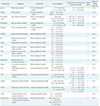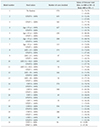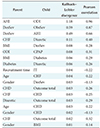1. Kronholm E, Sallinen M, Suutama T, Sulkava R, Era P, Partonen T. Self-reported sleep duration and cognitive functioning in the general population. J Sleep Res. 2009; 18(4):436–446.

2. Muraja-Murro A, Eskola K, Kolari T, Tiihonen P, Hukkanen T, Tuomilehto H, et al. Mortality in middle-aged men with obstructive sleep apnea in Finland. Sleep Breath. 2013; 17(3):1047–1053.

3. Rich J, Raviv A, Raviv N, Brietzke SE. All-cause mortality and obstructive sleep apnea severity revisited. Otolaryngol Head Neck Surg. 2012; 147(3):583–587.

4. Yaggi HK, Concato J, Kernan WN, Lichtman JH, Brass LM, Mohsenin V. Obstructive sleep apnea as a risk factor for stroke and death. N Engl J Med. 2005; 353(19):2034–2041.

5. Sullivan CE, Issa FG, Berthon-Jones M, Eves L. Reversal of obstructive sleep apnoea by continuous positive airway pressure applied through the nares. Lancet. 1981; 1(8225):862–865.

6. Giles TL, Lasserson TJ, Smith BH, White J, Wright J, Cates CJ. Continuous positive airways pressure for obstructive sleep apnoea in adults. Cochrane Database Syst Rev. 2006; (1):CD001106.

7. Wang X, Ouyang Y, Wang Z, Zhao G, Liu L, Bi Y. Obstructive sleep apnea and risk of cardiovascular disease and all-cause mortality: a meta-analysis of prospective cohort studies. Int J Cardiol. 2013; 169(3):207–214.

8. Spiegelhalter DJ, Myles JP, Jones DR, Abrams KR. Bayesian methods in health technology assessment: a review. Health Technol Assess. 2000; 4(38):1–130.

9. Sheingold SH. Can Bayesian methods make data and analyses more relevant to decision makers? A perspective from Medicare. Int J Technol Assess Health Care. 2001; 17(1):114–122.

10. Allmark P. Bayes and health care research. Med Health Care Philos. 2004; 7(3):321–332.

11. Woertman W, van der Wilt GJ. Estimating the effectiveness of HPV vaccination in the open population: a Bayesian approach. Value Health. 2013; 16(4):604–609.

12. Pearl J. Causality. 2nd ed. Cambridge: Cambridge University Press;2009.
13. American Academy of Sleep Medicine Task Force. Sleep-related breathing disorders in adults: recommendations for syndrome definition and measurement techniques in clinical research. Sleep. 1999; 22(5):667–689.
14. Kulkas A, Tiihonen P, Eskola K, Julkunen P, Mervaala E, Toyras J. Novel parameters for evaluating severity of sleep disordered breathing and for supporting diagnosis of sleep apnea-hypopnea syndrome. J Med Eng Technol. 2013; 37(2):135–143.

15. Kulkas A, Tiihonen P, Julkunen P, Mervaala E, Toyras J. Novel parameters indicate significant differences in severity of obstructive sleep apnea with patients having similar apnea-hypopnea index. Med Biol Eng Comput. 2013; 51(6):697–708.

16. Leppanen T, Toyras J, Muraja-Murro A, Kupari S, Tiihonen P, Mervaala E, Kulkas A. length of individual apnea events is increased by supine position and modulated by severity of obstructive sleep apnea. Sleep Disord. 2016; 2016:9645347.
17. Muraja-Murro A, Kulkas A, Hiltunen M, Kupari S, Hukkanen T, Tiihonen P, et al. Adjustment of apneahypopnea index with severity of obstruction events enhances detection of sleep apnea patients with the highest risk of severe health consequences. Sleep Breath. 2014; 18(3):641–647.

18. Leppanen T, Sarkka M, Kulkas A, Muraja-Murro A, Kupari S, Anttonen M, et al. RemLogic plug-in enables clinical application of apnea-hypopnea index adjusted for severity of individual obstruction events. J Med Eng Technol. 2016; 40(3):119–126.

19. Muraja-Murro A, Kulkas A, Hiltunen M, Kupari S, Hukkanen T, Tiihonen P, et al. The severity of individual obstruction events is related to increased mortality rate in severe obstructive sleep apnea. J Sleep Res. 2013; 22(6):663–669.

21. Kjaerulff UB, Madsen AL. Bayesian networks and influence diagrams. New York (NY): Springer-Verlag;2008.
22. Bai X. Tabu search enhanced Markov blanket classifier for high dimensional data sets. Pittsburg (PA): Carnegie Mellon University;2005.
23. Grunwald PD. The minimum description length principle. Cambridge (MA): MIT Press;2007.
24. Kekolahti P, Karikoski J, Riikonen A. The effect of an individual's age on the perceived importance and usage intensity of communications services: a Bayesian network analysis. Inf Syst Front. 2015; 17(6):1313–1333.

25. Kekolahti P, Kilkki K, Hammainen H, Riikonen A. Features as predictors of phone popularity: an analysis of trends and structural breaks. Telematics Inform. 2016; 33(4):973–989.

26. Kasza J, Solomon P. Comparing score-based methods for estimating Bayesian networks using the Kullback-Leibler divergence. Commun Stat Theory Methods. 2015; 44(1):135–152.

27. Shamilov A, Asan Z, Giriftinoglu C. Estimation by MinxEnt principle. In : Proceedings of the 9th WSEAS International Conference on Applied Mathematics (WSEAS); 2006 May 27-29; Istanbul, Turkey. p. 436–440.
28. Friedman N. The Bayesian structural EM algorithm. In : Proceedings of the 14th Conference on Uncertainty in Artificial Intelligence; 1998 Jul 24-26; Madison, WI. p. 129–138.
29. Textor J, Hardt J, Knuppel S. DAGitty: a graphical tool for analyzing causal diagrams. Epidemiology. 2011; 22(5):745.
30. Pearl J, Mackenzie D. The ladder of causation. The book of why: the new science of cause and effect. New York (NY): Basic Books;2018. p. 23–52.
31. Kendzerska T, Gershon AS, Hawker G, Leung RS, Tomlinson G. Obstructive sleep apnea and risk of cardiovascular events and all-cause mortality: a decade-long historical cohort study. PLoS Med. 2014; 11(2):e1001599.

32. Marshall NS, Wong KK, Cullen SR, Knuiman MW, Grunstein RR. Sleep apnea and 20-year follow-up for all-cause mortality, stroke, and cancer incidence and mortality in the Busselton Health Study cohort. J Clin Sleep Med. 2014; 10(4):355–362.

33. Meinow B, Kareholt I, Parker MG, Thorslund M. The effect of the duration of follow-up in mortality analysis: the temporal pattern of different predictors. J Gerontol B Psychol Sci Soc Sci. 2004; 59(3):S181–S189.

34. Jennum P, Tonnesen P, Ibsen R, Kjellberg J. All-cause mortality from obstructive sleep apnea in male and female patients with and without continuous positive airway pressure treatment: a registry study with 10 years of follow-up. Nat Sci Sleep. 2015; 7:43–50.

35. Kasai T, Narui K, Dohi T, Yanagisawa N, Ishiwata S, Ohno M, et al. Prognosis of patients with heart failure and obstructive sleep apnea treated with continuous positive airway pressure. Chest. 2008; 133(3):690–696.

36. Gottlieb DJ, Yenokyan G, Newman AB, O'Connor GT, Punjabi NM, Quan SF, et al. Prospective study of obstructive sleep apnea and incident coronary heart disease and heart failure: the sleep heart health study. Circulation. 2010; 122(4):352–360.

37. Cowie MR, Woehrle H, Wegscheider K, Angermann C, d'Ortho MP, Erdmann E, et al. Adaptive servo-ventilation for central sleep apnea in systolic heart failure. N Engl J Med. 2015; 373(12):1095–1105.

38. Yogasundaram H, Oudit GY. Increased mortality associated with adaptive servo-ventilation therapy in heart failure patients with central sleep apnea in the halted SERVE-HF Trial. Can J Cardiol. 2015; 31(9):1202–1203.

39. Woehrle H, Cowie MR, Eulenburg C, Suling A, Angermann C, d'Ortho MP, et al. Adaptive servo ventilation for central sleep apnoea in heart failure: SERVE-HF on-treatment analysis. Eur Respir J. 2017; 50(2):1601692.











 PDF
PDF ePub
ePub Citation
Citation Print
Print








 XML Download
XML Download